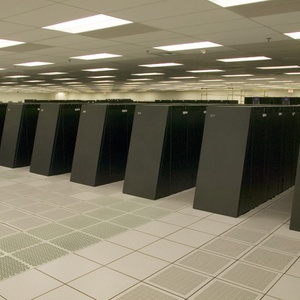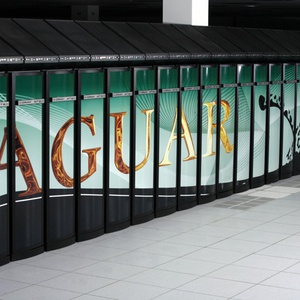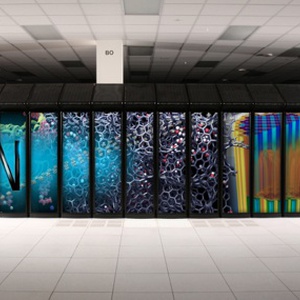
No.1 in Jun 1993
When the forerunner of today’s TOP500 List was published for the first time in June 1993, the No. 1 position was occupied by a CM-5 supercomputer made by Thinking Machines Corporation and installed at Los Alamos National Laboratory. With 1,024 processors, the CM-5 posted a 59.7 gigaflop/s performance running the Linpack benchmark. Not only did Thinking Machines take top honors, but the company built five of the top 10 systems on the list.
That first list was presented at the Mannheimer Supercomputer Seminar at the University of Mannheim in Germany. In 1993 the idea was born to abandon a fixed definition…

No.1 in Nov 1993
When the second list of the top500 supercomputers was presented at the 1993 Supercomputing Conference, it featured a new No. 1 system: the Numerical Wind Tunnel at the National Aerospace Laboratory of Japan. The Numerical Wind Tunnel was an early implementation of the vector parallel architecture developed in a joint project between the National Aerospace Laboratory of Japan and Fujitsu. The first deployment featured 140 vector processors and achieved 124.2 gigaflop/s performance running the Linpack benchmark.
The system lost the No. 1 spot in June 1994, but with an upgrade to 167 processors, the Numerical Wind Tunnel reclaimed the t…

No.1 in Jun 1994
In 1993, Sandia National Laboratories installed an Intel XP/S 140 Paragon super- computer, which claimed the No. 1 position on the June 1994 list. With 3,680 processors, the system ran the Linpack benchmark at 143.40 giGflop/s. It was the first massively parallel processor supercom- puter to be indisputably the fastest system in the world. The operating system, OSF-1, supplied by Intel for the Paragon failed to scale well. Sandia en- gineers ported SUNMOS, their lightweight kernel, to the Paragon. SUNMOS and associated runtime soft- ware became the basis of operations on the ma- chine. At the same time, Sandia began to devel…

No.1 in Jun 1996
The first six lists featured a see-saw battle between the United States and Japan for the No. 1 position. The seventh list, published at the Supercomputer 1996 in Mannheim, saw Japan maintain its hold on the top spot, but with the University of Tokyo displacing the National Aerospace Laboratory of Japan. The No. 1 system was a 1,024-processor SR2201 built by Hitachi. It achieved 232.4 gigaflops running the Linpack benchmark.
The Hitachi SR2201 was a distributed memory parallel system that was introduced in March 1996. Its processor, the 150 MHz HARP-1E based on the PA-RISC 1.1 architecture, solved the cache miss penalty…

No.1 in Nov 1996
The eighth TOP500 list was topped by a 2,048 processor CP-PAC built by Hitachi and installed at the Center for Computional Science at the University of Tsukuba in Japan. The system, which was a non-commercial extension of the Hitachi SR2201, achieved 368.20 gigaflops in running the Linpack benchmark. The CP-PACS Project aimed to develop a massively parallel computer designed to achieve high performance for numerical research of the major problems of computational physics. Planning started in the summer of 1991 and a proposal to the Ministry of Education, Science and Culture was approved in the spring of 1992 as one of projects of the …

No.1 from Jun 1997 until Jun 2000
Intel’s ASCI Red supercomputer was the first teraflop/s computer, taking the No.1 spot on the 9th TOP500 list in June 1997 with a Linpack performance of 1.068 teraflop/s.
Intel’s ASCI Red marked the beginning of a new supercomputer era. In the mid-90s when vector computers started to become less important, The U.S. Department of Energy’s ASCI (Accelerated Strategic Computing Initiative) program, which focused on defense applications, opened up a completely new source of funds. ASCI Red was the first product of this initiative and laid the foundation for the U.S. dominance in the production and implementa…

No.1 from Jun 2002 until Jun 2004
The Earth Simulator supercomputer at the Earth Simulator Center in yokohama, Japan, took the No. 1 spot in June 2002 with a performance of 35.86 Tflop/s (trillions of calculations per second) running the Linpack benchmark – almost five times higher than the performance of the IBM ASCI White system that had stood at the top of the previous three lists. This powerful leapfrogging to the top by a system so much faster than the previous top system is unparalleled in the history of the TOP500. The performance gap also kept the Earth System at No. 1 for five consecutive lists.
The Earth Simulator was a highly parallel vector supercompu…

No.1 from Nov 2000 until Nov 2001
The IBM ASCI White system located at Lawrence Livermore National Laboratory took the No. 1 position in November 2000 with 4.9 teraflop/s Linpack performance. This system was built with 512 nodes, each of which contained 16 IBM Power3 processors using a shared memory. This type of hierarchical architecture was becoming more and more common for systems used in HPC.
By June 2001, Linpack performance on ASCI White had improved to 7.2 teraflop/s, keeping it in the No. 1 position for two more lists.
Located in a classified area at Lawrence Livermore National Laboratory, ASCI White was housed in over two hundred cabinets and covered a space …

No.1 from Nov 2004 until Nov 2007
In November 2004, the DOE/IBM BlueGene/L beta system was able to claim the No. 1 position with its record Linpack benchmark performance of 70.72 teraflop/s. This system was assembled and tested at the IBM Rochester site. Once completed, the machine was moved to Lawrence Livermore National Laboratory in Livermore, Calif. In what became a familiar pattern, BlueGene/L was upgraded three times, keeping it atop seven consecutive lists.
In June 2005, the system was doubled in size from the original configuration and reached a new record Linpack benchmark performance of 136.8 TFlop/s. By November 2005, BlueGene/L had again been doubled…

No.1 from Jun 2008 until Jun 2009
In June 2008, the new No. 1 system was an IBM system installed the U.S. Department of Energy’s Los Alamos National Laboratory and called “Roadrunner.” The machined achieved performance of 1.026 petaflop/s — becoming the first supercomputer ever to reach this milestone. At the same time, Roadrunner was also one of the most energy efficient systems on the TOP500.
The Roadrunner system is based on the IBM QS22 blades which were built with advanced versions of the processor in the Sony PlayStation 3. Roadrunner differed from many contemporary supercomputers in that it was a hybrid system, using two different proce…

No.1 from Nov 2009 until Jun 2010
In its third run to knock the IBM supercomputer nicknamed “Roadrunner” off the top perch on the TOP500 list of supercomputers, the Cray XT5 supercomputer known as Jaguar finally claimed the top spot on the 34th edition of the list in November 2009. Jaguar was located at the Department of Energy’s Oak Ridge Leadership Computing Facility. Jaguar posted a Linpack performance of 1.759 petaflop/s and became only the second computer to break the petaflops barrier.
The Jaguar system went through a series of upgrades since installation as a 25-teraflop Cray XT3 in 2005. By early 2008, Jaguar was a 263-ter…

No.1 in Nov 2010
The 36th edition of the TOP500 list confirmed the rumored takeover of the top spot by the Chinese Tianhe-1A system at the National Supercomputer Center in Tianjin, achieving a performance level of 2.57 petaflop/s. The event marked the first time a Chinese system topped the list.
Rumors about the performance of Tianhe-1 (meaning River in Sky) began to circulate in October 2010 and were confirmed when the system was unveiled at HPC 2010 China that month. Designed by the National University of Defense Technology (NUDT) in China, the supercomputer was used to address research problems in petroleum exploration and the s…

No.1 from Jun 2011 until Nov 2011
In June 2011, a Japanese supercomputer capable of performing 8.16 quadrillion calculations per second (petaflop/s) became the new number one system, putting Japan back in the top spot for the first time since the Earth Simulator was dethroned in November 2004. The system, called the K computer, is at the RIKEN Advanced Institute for Computational Science (AICS) in Kobe. The K computer is named for the Japanese word "kei", which stands for 10 quadrillion.
The K computer, built by Fujitsu, originally combined 68,544 SPARC64 VIIIfx CPUs, each with eight cores, for a total of 548,352 cores—almost twice as many as any other …

No.1 in Jun 2012
For the first time since November 2009, a United States supercomputer sat atop the TOP500 list in June 2012. Named Sequoia, the IBM BlueGene/Q system installed at the Department of Energy’s Lawrence Livermore National Laboratory achieved 16.32 petaflop/s performance running the Linpack benchmark using 1,572,864 cores. Sequoia was the first system to be built using more than one million cores.
Sequoia is primarily water cooled and consists of 96 racks; 98,304 compute nodes; 1.6 million cores; and 1.6 petabytes of memory. Though orders of magnitude more powerful than such predecessor systems as ASC Purple and B…

No.1 in Nov 2012
When the 40th edition of the list was released at the start of SC12, the No. 1 position was claimed by Titan, a 560,640 processor system with a Linpack performance of 17.6 petaflop/s. Oak Ridge National Laboratory's Titan is a Cray XK7 system that relies on a combination of GPUs and traditional CPUs to make it the world's most powerful supercomputer. Each of Titan's 18,688 nodes contains an NVIDIA Tesla K20 GPU along with a 16-core AMD Opteron 6274 CPU processor, giving the system a peak performance of more than 27 petaflops. Titan also has more than 700 terabytes of memory.
Titan's use of GPUs also points the way f…

No.1 from Jun 2013 until Nov 2015
Tianhe-2, a supercomputer developed by China’s National University of Defense Technology, retains its position as the world’s No. 1 system with a performance of 33.86 petaflop/s (quadrillions of calculations per second) on the Linpack benchmark. It was built by China's National University of Defense Technology (NUDT) in collaboration with the Chinese IT firm Inspur.
According to NUDT, Tianhe-2 will be used for simulation, analysis, and government security applications. With 16,000 computer nodes, each comprising two Intel Ivy Bridge Xeon processors and three Xeon Phi chips, it represe…

No.1 from Jun 2016 until Nov 2017
TaihuLight is currently up and running at the National Supercomputing Center in the city of Wuxi, a manufacturing and technology hub, a two-hour drive west of Shanghai. The system will be used for various research and engineering work, in areas such as climate, weather & earth systems modeling, life science research, advanced manufacturing, and data analytics.
The supercomputer was developed by the National Research Center of Parallel Computer Engineering & Technology (NRCPC), the same organization that designed TaihuLight’s predecessor, the Sunway BlueLight system, which is installed at the National Supercomputing Center in J…

No.1 from Jun 2018 until Nov 2019
Summit, an IBM-built supercomputer now running at the Department of Energy’s (DOE) Oak Ridge National Laboratory (ORNL), captured the number one spot with a performance of 122.3 petaflops on High Performance Linpack (HPL), the benchmark used to rank the TOP500 list. Summit has 4,356 nodes, each one equipped with two 22-core Power9 CPUs, and six NVIDIA Tesla V100 GPUs. The nodes are linked together with a Mellanox dual-rail EDR InfiniBand network.

No.1 from Jun 2020 until Jun 2022
Fugaku, is powered by Fujitsu’s 48-core A64FX SoC, becoming the first number one system on the list to be powered by ARM processors.
No.1 in Jun 2022
Frontier system at Oak Ridge National Laboratory (ORNL) in the US is based on the latest HPE Cray EX235a architecture and equipped with AMD EPYC 64C 2GHz processors, the system has 8,730,112 total cores, a power efficiency rating of 52.23 gigaflops/watt, and relies on gigabit ethernet for data transfer.
No.1 in Nov 2024
The new El Capitan system at the Lawrence Livermore National Laboratory in California, U.S.A., has debuted as the most powerful system on the list with an HPL score of 1.742 EFlop/s. It has 11,039,616 combined CPU and GPU cores and is based on AMD 4th generation EPYC processors with 24 cores at 1.8GHz and AMD Instinct MI300A accelerators. El Capitan relies on a Cray Slingshot 11 network for data transfer and achieves an energy efficiency of 58.89 Gigaflops/watt. This power efficiency rating helped El Capitan achieve No. 18 on the GREEN500 list as well.




















